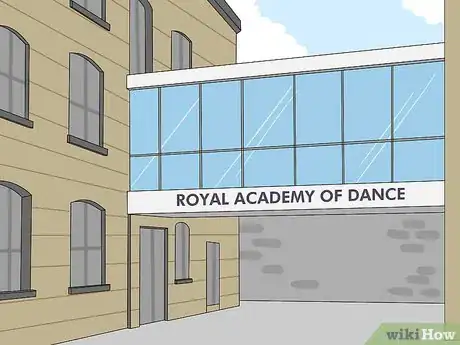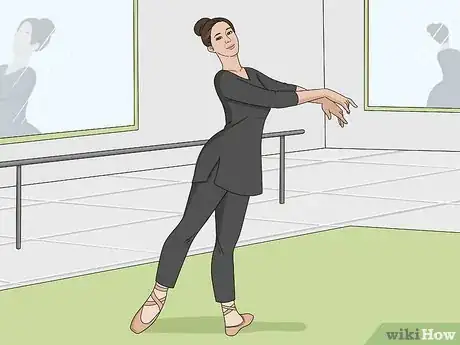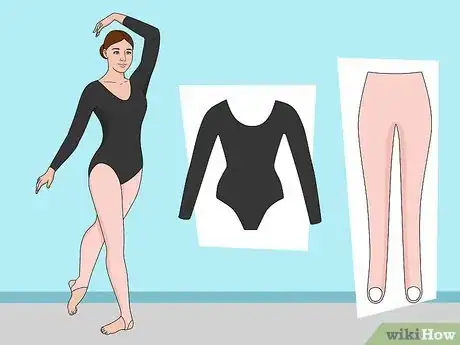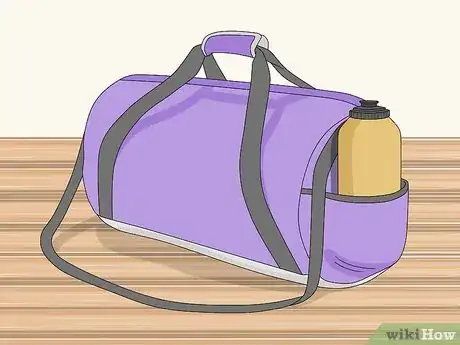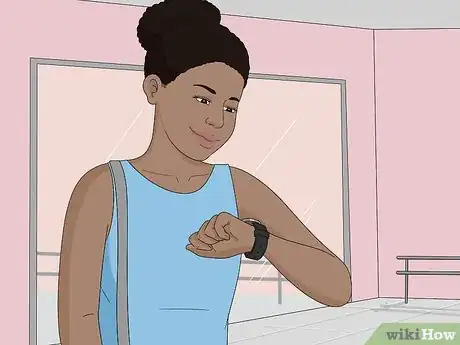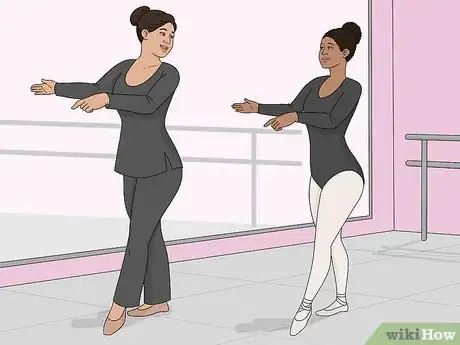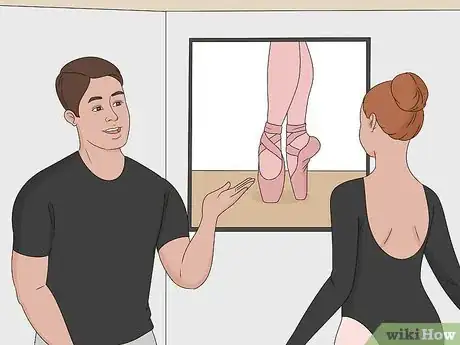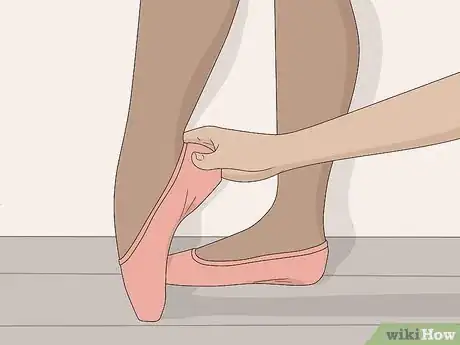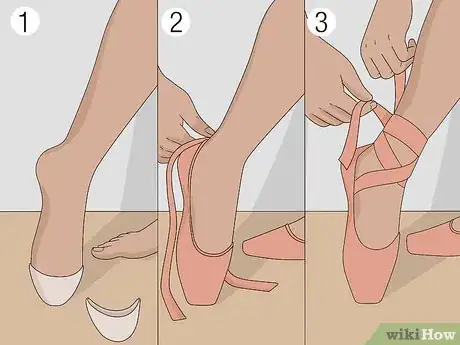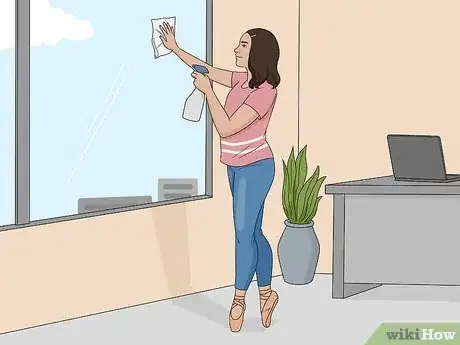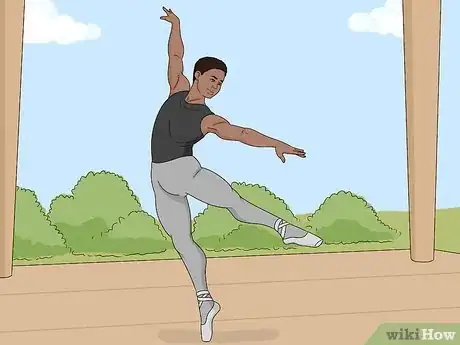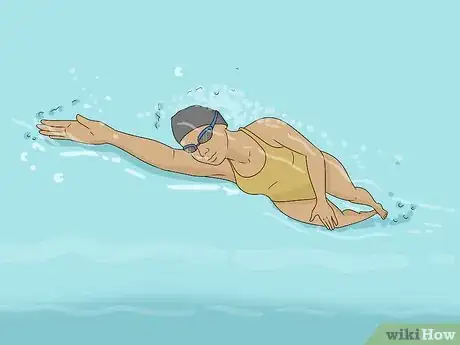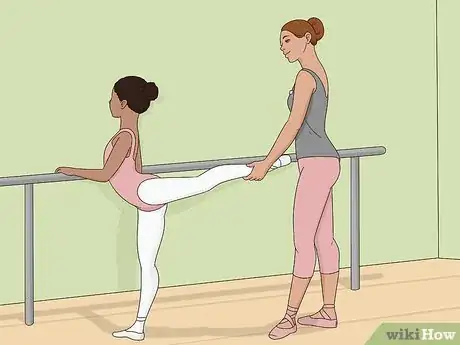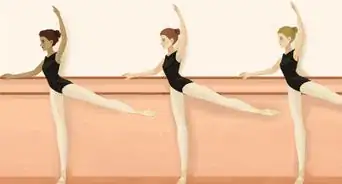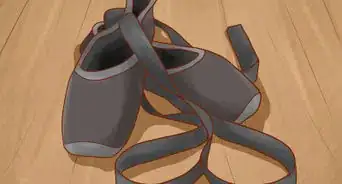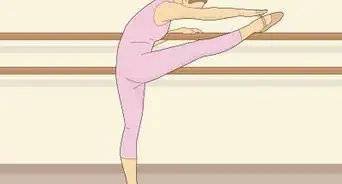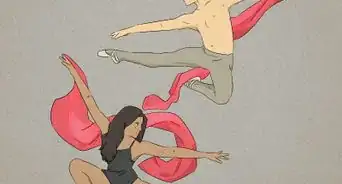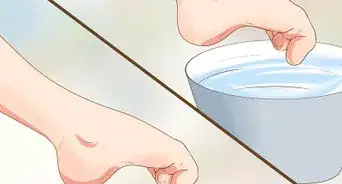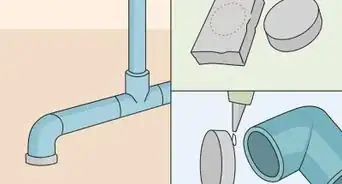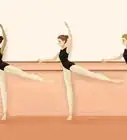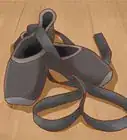This article was co-authored by Geraldine Grace Johns and by wikiHow staff writer, Amy Bobinger. Geraldine Grace Johns is a Professional Ballerina and the Owner of Grace Ballet in New York and Los Angeles. Geraldine toured through New Zealand, Australia, Japan, and Korea as Jammes in Ken Hill's Original Phantom of the Opera. She has studied with the Royal Academy of Dance in London to become a teacher and taught for the Kudo School of Ballet in Yokohama. Geraldine also ran her own Royal Academy of Dance School in New Zealand before studying at the Neighborhood Playhouse School of the Theatre in New York City. Geraldine was a guest coach and Master Class teacher in Toronto for the Canadian Royal Academy of Dance's Dance Challenge in 2018, 2019, and 2020. She was also a guest coach and Master Class teacher for the USA Royal Academy of Dance Challenge in Long Beach, California in 2019 and 2020. Grace Ballet Los Angeles has won recognition as one of 13 Best Ballet Schools in Los Angeles since opening her school. Geraldine is a contract Practical Teaching Supervisor for the Certificate in Ballet Teaching Studies for the Royal Academy of Dance.
There are 21 references cited in this article, which can be found at the bottom of the page.
This article has been viewed 249,123 times.
No matter your age, ballet is a fun way to strengthen your body while expressing yourself through the art of dance. If you're really passionate about it, you might even consider pursuing a professional ballet career. It won't always be easy, but with hard work and dedication, you could find yourself dancing center stage, just like the prima ballerinas you look up to today!
Steps
Taking Ballet Classes
-
1Choose a professional studio if you want to pursue dance seriously. If you want the type of dance training that could potentially prepare you for a career as a dancer, look for a professional studio when you start taking classes. In particular, look for a reputable school that uses a recognized ballet method like Royal Academy of Dance (RAD), Vaganova, or Cecchetii.[1]
- Professional ballet schools typically have ties to well-known ballet organizations, so you'll have more opportunities to dance in professional productions. They also provide annual examinations to critique your progress as a dancer.
-
2Take classes at a recreational studio if you just want to dance for fun. If you want to dance ballet but you're not as concerned about a long-term career, sign up for classes at a recreational studio. However, do still take the time to find a reputable school with experienced instructors—learning good technique is an important part of avoiding injuries while you dance.[2]
- Recreational schools often focus on a big recital at the end of the year rather than preparing you for professional opportunities. Depending on where you live, it might be easier to find recreational schools near you.
Advertisement -
3Find an experienced dance teacher. If you take classes from an inexperienced dance teacher, you could learn bad habits that can affect your form for the rest of your dance career. To avoid that, read up on each studio's instructors online or talk to them in person to find out where they trained. In particular, look for someone who:[3]
- Has trained with a professional company
- Is well-trained as an instructor, not just a dancer
- Has a dance degree or reputable certifications
- Has a good reputation in the dance community
- Makes you feel at ease
-
4Look for a studio that offers smaller classes, if possible. Ideally, try to join a studio that has no more than about 12 students in each class. Smaller classes mean you'll get more personalized attention from the dance instructor, so you'll be less likely to learn bad habits that slip by under the radar.[4]
- If a dance class has more than 12 students, it's a lot harder for the instructor to see what everyone is doing at all times.
- This is especially important if you're hoping to have a dance career, since you'll need a solid foundation with great technique. However, even if you're just dancing for fun, you'll still benefit from having an instructor who'll notice and correct you when your form isn't right.
-
5Dress in clothes that show your figure. When you're getting dressed for dance class, call ahead or check the school's website to see if there's a dress code. Some schools require females to wear pink or black tights and a leotard, while males are usually asked to wear a fitted white T-shirt and black tights or full-body tights.[5] However, some schools have more relaxed requirements, so you may be able to wear something like a tank top and leggings.[6]
- Wear your hair pulled up or pinned back from your face.[7]
-
6Wear ballet shoes that match your tights.[8] Most schools require you to wear ballet shoes to class because they'll help keep you from slipping on the dance floor. Ballet shoes fit a little differently than traditional shoes, so stop by a local dance store to make sure you get the best fit.[9]
- Pink shoes and pink tights are the most common option for ballet class, but if the studio allows, you can wear black shoes and black tights instead.
- Avoid wearing black shoes with pink tights—in the ballet world, this is considered tacky.[10]
- Do not wear pointe shoes until your instructor tells you that you're ready![11]
-
7Bring a water bottle and a bag with a change of clothes. Ballet can really get your heart pumping, so bring along some water to drink in case you get thirsty. In addition, bring a fresh change of clothes and a bag to put your sweaty dance clothes in after class.[12]
- Keep your dance shoes in a separate bag—it's important to keep them clean, so you don't want them tumbling around with your dirty dance clothes.
- Don't chew gum or eat candy during class—it could be a choking hazard![13]
-
8Show up to class 10-15 minutes early so you can warm up. It's always important to warm up before you do any type of exercise, but you might not get time to do that during your class. To be sure you get a chance to get your muscles moving before your teacher calls the students to the barre, show up a few minutes before class starts. [14]
- To warm up, do some stretches, as well as a few basic exercises to get your heart pumping, like jumping-jacks or running in place.[15]
-
9Pay close attention during your lessons. Give the instructor the respect they deserve and really listen to everything they say. If you're only half-heartedly going along with the moves, you're wasting your teacher's—and your own—time, not to mention the money you spent on the class. You could even be taking up a spot in the class that someone else wanted.[16]
- Being a dancer takes self-motivation, so if you find yourself feeling discouraged, try to tap into what made you want to dance in the first place.
- Try not to compare how you're doing to the other dancers in the room. Sometimes, you might be in a class with students who have more experience or natural ability than you, but it's important to only focus on what you're doing and how to be the best you can be.[17]
Dancing Pointe
-
1Wait to do pointe work until your instructor says you're ready. Moving to pointe shoes is a milestone that many ballet dancers look forward to. However, it's important not to start too soon—your feet have to be developed and strong enough to support you on pointe, or you could injure yourself.[18] Trust your instructor to let you know when you're ready.[19] Here are some of the criteria they'll use:
- Be at least 11 years old[20]
- Have taken at least 3 years of classes, preferably 3 times a week or more.
- Have proper turnout and a strong core
- Be able to do full pointe at the barre and in center
- Have the calf strength and enough of an arched instep to support you on pointe
-
2Get fitted for pointe shoes.[21] To make sure you get the perfect pointe shoes for your feet, go to a professional pointe shoe fitter for a consultation. They'll help you find the right size, and they'll also give you personalized recommendations based on the shape and condition of your feet.[22]
- Once you purchase your pointe shoes, you'll need to sew ribbons and elastics onto them. You may also want to press on the toe box or bend the soles of your pointe shoes—called the shanks—back and forth a few times to help break them in before you wear them.
- Every dancer has their own way to sew on elastics and break in their shoes. If you're not sure where to start, talk to the shoe fitter or your dance teacher for tips.
-
3Wear padding and tie your shoes securely. To put on your pointe shoes correctly, start by slipping a gel or wool pad over your toes. Then, put on your pointe shoes and tie them—the ribbons and elastics will hold the shoes on your feet while providing support for your ankles.[23]
- Over time, you'll figure out how to tie your shoes so they feel secure and comfortable. A good way to start is to wrap the inner strap (the one closest to your instep) around your leg twice, stopping on the inside of your ankle. Then, wrap the outer strap twice, tie the straps together on the inside of your leg, and tuck the ends under the straps.
-
4Build your endurance gradually. Dancing on pointe is often painful at first because you're using muscles that you don't normally use. As you practice over time, these muscles will get stronger, and you'll build up callouses that will help make it easier to dance on pointe.[24]
- Put on your pointe shoes for at least a few minutes every day, even on days you don't dance. That will help you keep the calluses that will allow you to dance on pointe.[25]
- Professional dancers are expected to be able to dance pointe for long periods at a time. Keep practicing until you can do a whole class on pointe.[26]
Becoming a Professional Dancer
-
1Take ballet classes at a reputable school for about 8-10 years. Becoming a professional dancer takes a lot of dedication. It takes years of perfecting your technique before you're ready to start dancing professionally. Sometimes, you might have to sacrifice hanging out with your friends or other after-school activities to pursue your goal. If you really love it though, it will be worth it!
- Most students start at about the age of 7, then take classes until they're in their teens. If you're a little older than that, you can still reach your goal, so don't give up on your dream. However, do be aware that it will take a lot of work—and a decent helping of natural talent.[27]
-
2Practice most days of the week to condition your body. If you want to be a professional dancer, just taking classes a couple of days a week isn't going to be enough. Plan to dance 5-6 days every single week to make sure you have the technique, muscle memory, and training to accomplish your goal.[28]
- Depending on where you live, you might need to take classes at more than one studio to get the training you'll need.
-
3Cross-train if you want to build additional strength. Ballet is great for strengthening your body, so if you don't have much time for extra exercise, don't worry too much about it. However, if you want to change things up a little and add a little extra muscle strength, consider adding in activities like swimming, cycling, and yoga.[29]
- These exercises are good for your joints so they'll help with your flexibility, and they use many of the same muscles as ballet.
-
4Eat a healthy diet that will fuel your body. As a ballet dancer, it's ideal to have a slender frame. However, avoid the temptation to starve yourself to get that ideal dancer's figure. If you want the stamina to work as a professional dancer, you'll need to follow a healthy diet that will fuel your body for long days.[30]
- Pay attention to what foods make you feel energized and which ones make you feel sluggish. That's different for everyone, but in general, lean proteins and plenty of fruits and veggies will give you the best boost, while foods that are high in processed carbs or unhealthy fats will probably make you feel weighed down.
- Professional dancers work long hours—on a typical day, you might dance from 10 am to 7 pm, or even later on a day with a performance.[31]
-
5Participate in evaluations, competitions, and open classes. Throughout your ballet career, you'll typically have opportunities to dance in performances, be judged in yearly evaluations, and take part in competitions. Try to take advantage of these whenever they come along—if you can catch the eye of a scout, you may be invited to take an open class with a dance company, which can open the door to even more opportunities down the road.[32]
- Summer intensives are ballet camps that are offered by dance companies. This is a great way to get additional dance experience!
- Be prepared to audition for roles so you can dance in various productions!
- Keep in mind that you'll likely need to travel for some of these opportunities.
-
6Accept a position as an apprentice if you're offered one. If you work hard and get noticed by the right people, you may be offered an apprenticeship with a dance company. Congratulations! This is basically an entry-level position for a professional dancer. You'll basically be an understudy for the core dancers, so even if you don't perform, you'll get the same training they do.[33]
- You'll probably need to move to a large city like New York to perform with a dance company.
-
7Continue working hard until you're promoted to a core member. Give your apprenticeship the same dedication that you would if you were dancing on stage. Eventually, your talent and devotion might just pay off and land you a spot as a core dancer in the company. At that point, you'll be given more opportunities to dance in company productions.[34]
- Keep working your very hardest—you might even be promoted to lead dancer if you really stand out!
Expert Q&A
Did you know you can get expert answers for this article?
Unlock expert answers by supporting wikiHow
-
QuestionHow many years does it take to go on pointe?
 Geraldine Grace JohnsGeraldine Grace Johns is a Professional Ballerina and the Owner of Grace Ballet in New York and Los Angeles. Geraldine toured through New Zealand, Australia, Japan, and Korea as Jammes in Ken Hill's Original Phantom of the Opera. She has studied with the Royal Academy of Dance in London to become a teacher and taught for the Kudo School of Ballet in Yokohama. Geraldine also ran her own Royal Academy of Dance School in New Zealand before studying at the Neighborhood Playhouse School of the Theatre in New York City. Geraldine was a guest coach and Master Class teacher in Toronto for the Canadian Royal Academy of Dance's Dance Challenge in 2018, 2019, and 2020. She was also a guest coach and Master Class teacher for the USA Royal Academy of Dance Challenge in Long Beach, California in 2019 and 2020. Grace Ballet Los Angeles has won recognition as one of 13 Best Ballet Schools in Los Angeles since opening her school. Geraldine is a contract Practical Teaching Supervisor for the Certificate in Ballet Teaching Studies for the Royal Academy of Dance.
Geraldine Grace JohnsGeraldine Grace Johns is a Professional Ballerina and the Owner of Grace Ballet in New York and Los Angeles. Geraldine toured through New Zealand, Australia, Japan, and Korea as Jammes in Ken Hill's Original Phantom of the Opera. She has studied with the Royal Academy of Dance in London to become a teacher and taught for the Kudo School of Ballet in Yokohama. Geraldine also ran her own Royal Academy of Dance School in New Zealand before studying at the Neighborhood Playhouse School of the Theatre in New York City. Geraldine was a guest coach and Master Class teacher in Toronto for the Canadian Royal Academy of Dance's Dance Challenge in 2018, 2019, and 2020. She was also a guest coach and Master Class teacher for the USA Royal Academy of Dance Challenge in Long Beach, California in 2019 and 2020. Grace Ballet Los Angeles has won recognition as one of 13 Best Ballet Schools in Los Angeles since opening her school. Geraldine is a contract Practical Teaching Supervisor for the Certificate in Ballet Teaching Studies for the Royal Academy of Dance.
Professional Ballerina & Ballet Instructor It's really your teacher's decision as to when you're ready to go on pointe. It does require many, many years of training and strengthening your footwork, calves, and feet. There are many factors that determine when you can go on pointe, including your age, the size of your feet and toes, and your level of strength.
It's really your teacher's decision as to when you're ready to go on pointe. It does require many, many years of training and strengthening your footwork, calves, and feet. There are many factors that determine when you can go on pointe, including your age, the size of your feet and toes, and your level of strength. -
QuestionWhat should I wear to ballet class?
 Geraldine Grace JohnsGeraldine Grace Johns is a Professional Ballerina and the Owner of Grace Ballet in New York and Los Angeles. Geraldine toured through New Zealand, Australia, Japan, and Korea as Jammes in Ken Hill's Original Phantom of the Opera. She has studied with the Royal Academy of Dance in London to become a teacher and taught for the Kudo School of Ballet in Yokohama. Geraldine also ran her own Royal Academy of Dance School in New Zealand before studying at the Neighborhood Playhouse School of the Theatre in New York City. Geraldine was a guest coach and Master Class teacher in Toronto for the Canadian Royal Academy of Dance's Dance Challenge in 2018, 2019, and 2020. She was also a guest coach and Master Class teacher for the USA Royal Academy of Dance Challenge in Long Beach, California in 2019 and 2020. Grace Ballet Los Angeles has won recognition as one of 13 Best Ballet Schools in Los Angeles since opening her school. Geraldine is a contract Practical Teaching Supervisor for the Certificate in Ballet Teaching Studies for the Royal Academy of Dance.
Geraldine Grace JohnsGeraldine Grace Johns is a Professional Ballerina and the Owner of Grace Ballet in New York and Los Angeles. Geraldine toured through New Zealand, Australia, Japan, and Korea as Jammes in Ken Hill's Original Phantom of the Opera. She has studied with the Royal Academy of Dance in London to become a teacher and taught for the Kudo School of Ballet in Yokohama. Geraldine also ran her own Royal Academy of Dance School in New Zealand before studying at the Neighborhood Playhouse School of the Theatre in New York City. Geraldine was a guest coach and Master Class teacher in Toronto for the Canadian Royal Academy of Dance's Dance Challenge in 2018, 2019, and 2020. She was also a guest coach and Master Class teacher for the USA Royal Academy of Dance Challenge in Long Beach, California in 2019 and 2020. Grace Ballet Los Angeles has won recognition as one of 13 Best Ballet Schools in Los Angeles since opening her school. Geraldine is a contract Practical Teaching Supervisor for the Certificate in Ballet Teaching Studies for the Royal Academy of Dance.
Professional Ballerina & Ballet Instructor I recommend wearing flat ballet shoes with elastics, a leotard or fitted dance t-shirt, and tights. If you are cold, try adding a crossover cardigan. Avoid wearing baggy clothes like sweatpants or an oversized T-shirt. Your instructor needs to be able to see the lines of your body to make sure you're performing the moves correctly. In addition, baggy clothes can affect your movement and could create a tripping hazard as you dance.
I recommend wearing flat ballet shoes with elastics, a leotard or fitted dance t-shirt, and tights. If you are cold, try adding a crossover cardigan. Avoid wearing baggy clothes like sweatpants or an oversized T-shirt. Your instructor needs to be able to see the lines of your body to make sure you're performing the moves correctly. In addition, baggy clothes can affect your movement and could create a tripping hazard as you dance. -
QuestionHow can I become a better ballet dancer?
 Community AnswerPractice, dedication, and time. You also need to be prepared for challenging classes, and sometimes fun. As a dancer, you sacrifice a lot of time with your friends for more time practicing your ballet.
Community AnswerPractice, dedication, and time. You also need to be prepared for challenging classes, and sometimes fun. As a dancer, you sacrifice a lot of time with your friends for more time practicing your ballet.
References
- ↑ https://www.opusbellingham.com/blog/factors-to-consider-in-choosing-a-ballet-school
- ↑ https://www.kotb.com.au/6-things-know-choose-ballet-school/
- ↑ https://www.opusbellingham.com/blog/factors-to-consider-in-choosing-a-ballet-school
- ↑ https://www.opusbellingham.com/blog/factors-to-consider-in-choosing-a-ballet-school
- ↑ https://www.rockettes.com/blog/what-to-expect-your-first-ballet-class/
- ↑ https://www.kotb.com.au/6-things-know-choose-ballet-school/
- ↑ https://www.rockettes.com/blog/what-to-expect-your-first-ballet-class/
- ↑ Geraldine Grace Johns. Professional Ballerina & Ballet Instructor. Expert Interview. 11 November 2020.
- ↑ https://www.kotb.com.au/6-things-know-choose-ballet-school/
- ↑ https://thelastdancer.com/what-to-wear-in-ballet-class/
- ↑ Geraldine Grace Johns. Professional Ballerina & Ballet Instructor. Expert Interview. 11 November 2020.
- ↑ https://www.rockettes.com/blog/what-to-expect-your-first-ballet-class/
- ↑ https://www.rockettes.com/blog/what-to-expect-your-first-ballet-class/
- ↑ https://www.rockettes.com/blog/what-to-expect-your-first-ballet-class/
- ↑ https://www.rockettes.com/blog/what-to-expect-your-first-ballet-class/
- ↑ https://youtu.be/FgKwMJXI06M?t=30
- ↑ https://www.rockettes.com/blog/what-to-expect-your-first-ballet-class/
- ↑ Geraldine Grace Johns. Professional Ballerina & Ballet Instructor. Expert Interview. 11 November 2020.
- ↑ https://www.opusbellingham.com/blog/factors-to-consider-in-choosing-a-ballet-school
- ↑ https://www.ortho.wustl.edu/content/Patient-Care/3496/Services/Physical-Medicine-and-Rehabilitation/Performing-Arts-Program/Criteria-for-Pointe-Work.aspx
- ↑ Geraldine Grace Johns. Professional Ballerina & Ballet Instructor. Expert Interview. 11 November 2020.
- ↑ https://www.danceinforma.com/2019/04/24/10-pointe-shoe-myths-busted/
- ↑ https://youtu.be/GWGPOHZazgY?t=123
- ↑ https://youtu.be/fFnvGEf1ZgA?t=47
- ↑ https://www.dancespirit.com/practice-pointe-at-home-2645813930.html?rebelltitem=3#rebelltitem3
- ↑ https://youtu.be/FgKwMJXI06M?t=246
- ↑ https://www.dancespirit.com/starting-ballet-late-2541387120.html
- ↑ https://youtu.be/FgKwMJXI06M?t=99
- ↑ https://www.bbc.com/news/entertainment-arts-25240771
- ↑ https://youtu.be/FgKwMJXI06M?t=312
- ↑ https://www.cosmopolitan.com/career/interviews/a34710/get-that-life-alicia-graf-mack-ballerina/
- ↑ https://www.cosmopolitan.com/career/interviews/a34710/get-that-life-alicia-graf-mack-ballerina/
- ↑ https://www.cosmopolitan.com/career/interviews/a34710/get-that-life-alicia-graf-mack-ballerina/
- ↑ https://www.cosmopolitan.com/career/interviews/a34710/get-that-life-alicia-graf-mack-ballerina/
- ↑ https://www.kotb.com.au/6-things-know-choose-ballet-school/
